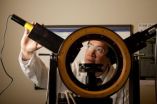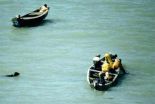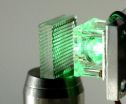(Press-News.org) HOUSTON, Jan. 20, 2011 – Monitoring everything from explosives to tainted milk, materials for use in creating sensors for detection devices have been developed by a University of Houston (UH) chemist and his team. The findings recently appeared simultaneously in three journals.
"There are many dangerous substances, pollutants and infectious bacteria we are constantly exposed to," said Rigoberto Advincula, a highly cited materials scientist at UH. "Our work is poised to assist in such efforts as rapidly detecting explosives or banned substances in airports for homeland security, as well as monitoring commercial products like milk and pet food for substandard additive products. There is a need to measure this quantitatively and in a rapid manner."
In a two-stage effort on which a provisional patent has been filed, Advincula's team fabricated the polymer materials and then built a device that was used as a sensor. The work is based on what he calls "the artificial receptor concept." This is akin to an enzyme functioning as a biochemical catalyst within a cell, like an antibody, binding with specific molecules to produce a specific effect in the cell. The elements in Advincula's work, however, deal with metals and plastics and are called molecular imprinted polymers (MIP), a concept also used for making plastic antibodies. These polymers show a certain chemical affinity for the original molecule and can be used to fabricate sensors.
Based in electrochemistry, the films were prepared by electrodeposition, a process similar to electroplating used for metals in the automotive and metal industries. Their key innovation was to use a process called electropolymerization directly on a gold surface and attached to a digital read out. The group's next step is to put this film on portable devices, thus acting as sensors.
"Our materials and methods open up these applications toward portable devices and miniaturization. Our device will allow, in principle, the development of hand-held scanners for bomb detection or nerve agent detection in airports," Advincula said. "This means accurate answers in a rapid manner without loss of time or use of complicated instruments. We can achieve very high sensitivity and selectivity in sensing. The design of our molecules and their fabrication methods have been developed in a simple, yet effective, manner."
The culmination of a year's work, the research being published simultaneously in three journals is a record for Advincula's group. These publications – Macromolecules, Applied Materials & Intefaces, and Biosensors & Bioelectronics – are among some of the most prestigious and highly cited in this area of study.
Macromolecules is the most-cited journal on polymer science, and Applied Materials & Intefaces is an upcoming international forum for applied materials science and engineering. Both are put out by the American Chemical Society (ACS), which provides a comprehensive collection of well-cited, peer-reviewed journals in the chemical sciences. Biosensors & Bioelectronics is the principal international journal devoted to research, design, development and application of such devices and is published by Elsevier, one of the world's leading publishers of science and health information.
In the coming year, the researchers hope to expand the work to many other types of dangerous chemicals and also to proteins given off by pathogens. Ultimately, they plan to create portable hand-held devices for detection that will be made commercially available to the general public, as well as being of interest to the military. Advincula plans to seek additional funding and collaborators to reach these goals. Advincula currently has funding from the National Science Foundation and also works in collaboration with some companies.
Student success is another key element that Advincula emphasizes. In addition to becoming an ACS fellow last year, he received UH's undergraduate research mentoring award and is particularly committed to student success in a materials discovery environment. He says there are few labs like his that have the capability to develop all the chemistry in concert with developing the device and doing the surface analysis all in one location. The set-up provides students a unique environment for discovery.
INFORMATION:
The two students working on this project who are being trained in his lab are Roderick Pernites and Ramakrishna Ponnapati. Pernites, who is finishing his Ph.D. this semester, recently received the ACS best poster award in the colloids division and currently has eight publications in Advincula's group. Ponnapati, who studied under Advincula and received his Ph.D. in 2009, is now a postdoctoral researcher in UH's department of chemical and biomolecular engineering and previously received a best student award with the Society of Plastic Engineers chapter in Houston.
NOTE TO JOURNALISTS: High-resolution photos of Rigoberto Advincula are available to media by contacting Lisa Merkl.
About the University of Houston
The University of Houston is a comprehensive national research institution serving the globally competitive Houston and Gulf Coast Region by providing world-class faculty, experiential learning and strategic industry partnerships. UH serves more than 38,500 students in the nation's fourth-largest city, located in the most ethnically and culturally diverse region of the country.
About the College of Natural Sciences and Mathematics
The UH College of Natural Sciences and Mathematics, with 181 ranked faculty and approximately 4,500 students, offers bachelor's, master's and doctoral degrees in the natural sciences, computational sciences and mathematics. Faculty members in the departments of biology and biochemistry, chemistry, computer science, earth and atmospheric sciences, mathematics and physics conduct internationally recognized research in collaboration with industry, Texas Medical Center institutions, NASA and others worldwide.
For more information about UH, visit the university's Newsroom at http://www.uh.edu/news-events/.
To receive UH science news via e-mail, sign up for UH-SciNews at http://www.uh.edu/news-events/mailing-lists/sciencelistserv/index.php.
For additional news alerts about UH, follow us on Facebook at http://www.facebook.com/UHNewsEvents and Twitter at http://twitter.com/UH_News.
Sensors to detect explosives, monitor food being developed at UH
Rigoberto Advincula publishes key findings simultaneously in 3 high-impact journals
2011-01-22
ELSE PRESS RELEASES FROM THIS DATE:
Could oysters be used to clean up Chesapeake Bay?
2011-01-22
Madison, WI JANUARY 20, 2011 -- Chronic water quality problems caused by agricultural and urban runoff, municipal wastewater, and atmospheric deposition from the burning of fossil fuels leads to oxygen depletion, loss of biodiversity, and harmful algal blooms. This nutrient pollution is prevalent in many coastal marine and estuarine ecosystems worldwide. Chesapeake Bay is the largest estuary in North America and although many efforts have been taken to improve its water quality, nutrient pollution still keeps it at unacceptable levels.
In a study funded by the U.S. Environmental ...
Science learning easier when students put down textbooks and actively recall information
2011-01-22
Put down those science text books and work at recalling information from memory. That's the shorthand take away message of new research from Purdue University that says practicing memory retrieval boosts science learning far better than elaborate study methods.
"Our view is that learning is not about studying or getting knowledge 'in memory,'" said Purdue psychology professor Jeffrey Karpicke, the lead investigator for the study that appears today in the journal Science. "Learning is about retrieving. So it is important to make retrieval practice an integral part of the ...
HEPA filters reduce cardiovascular health risks associated with air pollution
2011-01-22
Using inexpensive air filters may help reduce cardiovascular disease risk that results from exposure to air pollution, according to researchers from Canada, who studied healthy adultsliving in a small community in British Columbia where wood burning stoves are the main sources of pollution. The researchers found that high efficiency particle air (HEPA)filters reduced the amount of airborne particulate matter, resulting in improved blood vessel health and reductions in blood markers that are associated with an increased risk of cardiovascular disease.
The findings were ...
CT scanning aids rapid diagnosis, treatment planning for abdominal pain
2011-01-22
The use of CT scanning to evaluate abdominal pain in emergency departments can help physicians arrive at a diagnosis quickly and decisively. A study conducted at Massachusetts General Hospital (MGH) and appearing in the February issue of the American Journal of Roentgenology also finds that information provided by CT scans changed treatment plans for almost half the patients studied and significantly reduced probable hospital admissions.
"Our report addresses an important question with substantial policy relevance – what is the value of CT scanning in the emergency ...
Why do some diabetics escape complications?
2011-01-22
"The majority of diabetics will over time develop severe or fatal complications, but 10 per cent never do. They are the ones we are interested in in the PROLONG study", explains Valeriya Lyssenko, who along with Peter Nilsson, both from Lund University Diabetes Centre, leads the PROLONG study.
Stiff sugary arteries:
Despite decades of intensive research on diabetes complications, the fundamental mechanisms are not yet fully known. Neither is it possible to prevent or treat the damage to the blood vessels that affects the majority of diabetics.
The risk of ...
Monk seal and hump-backed dolphin are threatened by fishing activities off coast of Mauritania
2011-01-22
Catalan researchers have studied the marine trophic network in Mauritania, on the north west coast of Africa, which is an extremely heavily exploited fishing area, as well as being home to two of the world's most threatened species of marine mammal – the monk seal and the Atlantic hump-backed dolphin. The results of the study show that industrial and traditional fishing activities along the coast are putting these mammals and local marine ecosystems at great danger.
The researchers studied the local marine trophic network off the north west coast of Africa, and by analysing ...
Montrealers are feeding fish Prozac
2011-01-22
This press release is available in French.
Around one in four Montrealers take some kind of anti-depressant, and according to new research, the drugs are passing into the waterways and affecting fish. The findings are internationally significant as the city's sewage treatment system is similar to that in use in other major cities, and moreover, it is reputed to be the third largest treatment system in the world. Lead by Dr. Sébastien Sauvé at the University of Montreal's Department of Chemistry and André Lajeunesse, a PhD candidate, the research team found that the ...
New Anglo-Swiss research questions impact of GM wheat on insects
2011-01-22
An Anglo-Swiss research project has found that the impact of disease-resistant genetically-modified wheat plants on insects may be negligible.
Many studies have looked at the effects of genetically-modified (GM) plants on single non-target insects. However, agro-ecosystems are characterised by numerous insect species forming food webs. This study is the first to investigate different transgenic disease-resistant wheat lines and their effect on the structure of whole aphid-parasitoid food webs.
The findings are published this week in the Royal Society journal, Biology ...
Nanoworld in color
2011-01-22
This press release is available in German.
Lights off – projector on. Lecture theaters, conference halls and seminar rooms currently have to be darkened if the speaker wants to project a presentation on screen. Unfortunately, the attention of the listeners goes off with the lights, and tiredness takes over. A new technique promises to remedy this situation. The projectors of the futur will not only be small and easy to use but also shine so brightly that the images appear sharp and clear, even in a sun-filled room.
The image illuminating the wall of the Fraunhofer ...
Researchers reveal function of novel molecule that underlies human deafness
2011-01-22
New research from the University of Sheffield has revealed that the molecular mechanism underlying deafness is caused by a mutation of a specific microRNA called miR-96. The discovery could provide the basis for treating progressive hearing loss and deafness.
The research team, led by Dr Walter Marcotti, Royal Society University Research Fellow from the University's Department of Biomedical Science, in collaboration with Professor Karen Steel at the Sanger Institute in Cambridge, discovered that the mutation in miR-96 prevents development of the auditory sensory hair ...
LAST 30 PRESS RELEASES:
The Lancet Obstetrics, Gynecology, & Women’s Health: Taking paracetamol during pregnancy does not increase risk of autism, ADHD or intellectual disabilities, confirms new gold-standard evidence review
Taking paracetamol during pregnancy does not increase risk of autism, ADHD or intellectual disabilities
Harm reduction vending machines in New York State expand access to overdose treatment and drug test strips, UB studies confirm
University of Phoenix releases white paper on Credit for Prior Learning as a catalyst for internal mobility and retention
Canada losing track of salmon health as climate and industrial threats mount
Molecular sieve-confined Pt-FeOx catalysts achieve highly efficient reversible hydrogen cycle of methylcyclohexane-toluene
Investment in farm productivity tools key to reducing greenhouse gas
New review highlights electrochemical pathways to recover uranium from wastewater and seawater
Hidden pollutants in shale gas development raise environmental concerns, new review finds
Discarded cigarette butts transformed into high performance energy storage materials
Researchers highlight role of alternative RNA splicing in schizophrenia
NTU Singapore scientists find new way to disarm antibiotic-resistant bacteria and restore healing in chronic wounds
Research suggests nationwide racial bias in media reporting on gun violence
Revealing the cell’s nanocourier at work
Health impacts of nursing home staffing
Public views about opioid overdose and people with opioid use disorder
Age-related changes in sperm DNA may play a role in autism risk
Ambitious model fails to explain near-death experiences, experts say
Multifaceted effects of inward foreign direct investment on new venture creation
Exploring mutations that spontaneously switch on a key brain cell receptor
Two-step genome editing enables the creation of full-length humanized mouse models
Pusan National University researchers develop light-activated tissue adhesive patch for rapid, watertight neurosurgical sealing
Study finds so-called super agers tend to have at least two key genetic advantages
Brain stimulation device cleared for ADHD in the US is overall safe but ineffective
Scientists discover natural ‘brake’ that could stop harmful inflammation
Tougher solid electrolyte advances long-sought lithium metal batteries
Experts provide policy roadmap to reduce dementia risk
New 3D imaging system could address limitations of MRI, CT and ultrasound
First-in-human drug trial lowers high blood fats
Decades of dredging are pushing the Dutch Western Scheldt Estuary beyond its ecological limits
[Press-News.org] Sensors to detect explosives, monitor food being developed at UHRigoberto Advincula publishes key findings simultaneously in 3 high-impact journals



